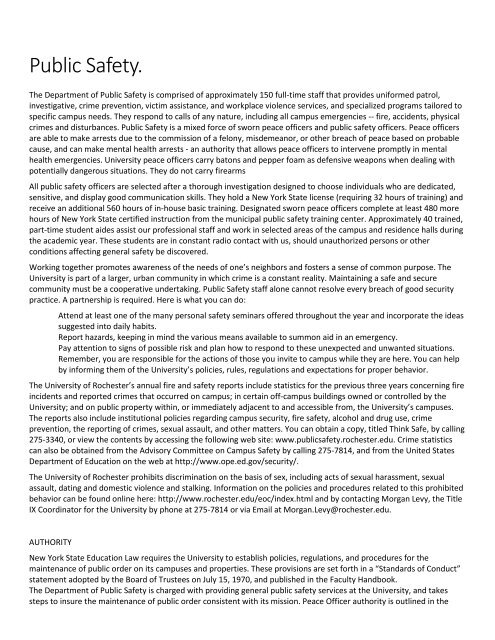mySimon student handbook
Create successful ePaper yourself
Turn your PDF publications into a flip-book with our unique Google optimized e-Paper software.
Public Safety.<br />
The Department of Public Safety is comprised of approximately 150 full-time staff that provides uniformed patrol,<br />
investigative, crime prevention, victim assistance, and workplace violence services, and specialized programs tailored to<br />
specific campus needs. They respond to calls of any nature, including all campus emergencies -- fire, accidents, physical<br />
crimes and disturbances. Public Safety is a mixed force of sworn peace officers and public safety officers. Peace officers<br />
are able to make arrests due to the commission of a felony, misdemeanor, or other breach of peace based on probable<br />
cause, and can make mental health arrests - an authority that allows peace officers to intervene promptly in mental<br />
health emergencies. University peace officers carry batons and pepper foam as defensive weapons when dealing with<br />
potentially dangerous situations. They do not carry firearms<br />
All public safety officers are selected after a thorough investigation designed to choose individuals who are dedicated,<br />
sensitive, and display good communication skills. They hold a New York State license (requiring 32 hours of training) and<br />
receive an additional 560 hours of in-house basic training. Designated sworn peace officers complete at least 480 more<br />
hours of New York State certified instruction from the municipal public safety training center. Approximately 40 trained,<br />
part-time <strong>student</strong> aides assist our professional staff and work in selected areas of the campus and residence halls during<br />
the academic year. These <strong>student</strong>s are in constant radio contact with us, should unauthorized persons or other<br />
conditions affecting general safety be discovered.<br />
Working together promotes awareness of the needs of one’s neighbors and fosters a sense of common purpose. The<br />
University is part of a larger, urban community in which crime is a constant reality. Maintaining a safe and secure<br />
community must be a cooperative undertaking. Public Safety staff alone cannot resolve every breach of good security<br />
practice. A partnership is required. Here is what you can do:<br />
Attend at least one of the many personal safety seminars offered throughout the year and incorporate the ideas<br />
suggested into daily habits.<br />
Report hazards, keeping in mind the various means available to summon aid in an emergency.<br />
Pay attention to signs of possible risk and plan how to respond to these unexpected and unwanted situations.<br />
Remember, you are responsible for the actions of those you invite to campus while they are here. You can help<br />
by informing them of the University’s policies, rules, regulations and expectations for proper behavior.<br />
The University of Rochester’s annual fire and safety reports include statistics for the previous three years concerning fire<br />
incidents and reported crimes that occurred on campus; in certain off-campus buildings owned or controlled by the<br />
University; and on public property within, or immediately adjacent to and accessible from, the University’s campuses.<br />
The reports also include institutional policies regarding campus security, fire safety, alcohol and drug use, crime<br />
prevention, the reporting of crimes, sexual assault, and other matters. You can obtain a copy, titled Think Safe, by calling<br />
275-3340, or view the contents by accessing the following web site: www.publicsafety.rochester.edu. Crime statistics<br />
can also be obtained from the Advisory Committee on Campus Safety by calling 275-7814, and from the United States<br />
Department of Education on the web at http://www.ope.ed.gov/security/.<br />
The University of Rochester prohibits discrimination on the basis of sex, including acts of sexual harassment, sexual<br />
assault, dating and domestic violence and stalking. Information on the policies and procedures related to this prohibited<br />
behavior can be found online here: http://www.rochester.edu/eoc/index.html and by contacting Morgan Levy, the Title<br />
IX Coordinator for the University by phone at 275-7814 or via Email at Morgan.Levy@rochester.edu.<br />
AUTHORITY<br />
New York State Education Law requires the University to establish policies, regulations, and procedures for the<br />
maintenance of public order on its campuses and properties. These provisions are set forth in a “Standards of Conduct”<br />
statement adopted by the Board of Trustees on July 15, 1970, and published in the Faculty Handbook.<br />
The Department of Public Safety is charged with providing general public safety services at the University, and takes<br />
steps to insure the maintenance of public order consistent with its mission. Peace Officer authority is outlined in the




